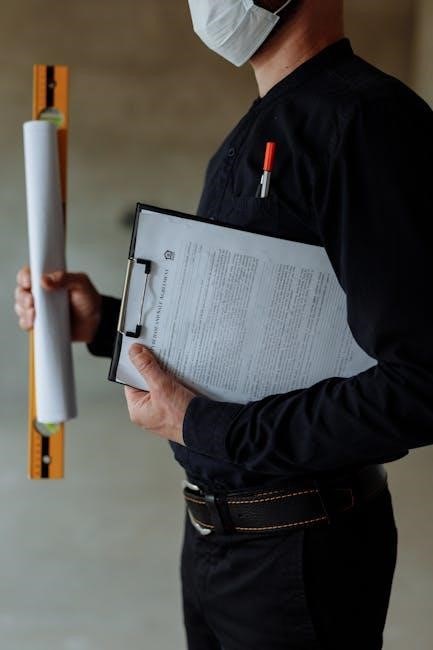
sample hold harmless agreement pdf
A Hold Harmless Agreement is a legal contract where one party (indemnitor) agrees to protect another (indemnitee) from liability‚ damages‚ or losses arising from specific activities. It is widely used to allocate risk and provide protection in business and legal dealings. This agreement is essential for ensuring that one party does not Hold Harmless Agreements are often required in contracts involving external services‚ events‚ or potentially risky operations. Having a written agreement helps prevent disputes and ensures clarity in obligations.
1.1 Definition and Purpose
A Hold Harmless Agreement is a legal contract where one party (the indemnitor) agrees to protect another (the indemnitee) from liability‚ claims‚ or damages arising from specific actions or events. Its primary purpose is to allocate risk and provide protection‚ ensuring the indemnitee is not held responsible for losses caused by the indemnitor’s actions. This agreement is essential in business and legal contexts to prevent disputes and clarify obligations‚ offering peace of mind for all parties involved.
1.2 Importance in Legal and Business Contexts
A Hold Harmless Agreement is crucial in legal and business contexts as it protects parties from potential liabilities. It ensures that one party cannot be held legally or financially responsible for damages caused by the other‚ minimizing risks. This is particularly vital in contractor-client relationships‚ event planning‚ and partnerships‚ where unforeseen incidents may occur. By establishing clear indemnification terms‚ it fosters trust and stability‚ enabling smooth operations and preventing costly disputes. Its legal enforceability makes it a cornerstone of risk management strategies.

Key Components of a Hold Harmless Agreement
A Hold Harmless Agreement typically includes indemnification clauses‚ names of parties‚ scope of coverage‚ and specific activities protected. It outlines the indemnitor’s responsibility to shield the indemnitee from liabilities arising from defined actions. This ensures clarity and mutual understanding‚ safeguarding both parties’ interests.
2.1 Parties Involved (Indemnitor and Indemnitee)
In a Hold Harmless Agreement‚ the indemnitor is the party assuming liability‚ while the indemnitee is the party being protected from claims or damages. The indemnitor agrees to defend and compensate the indemnitee for specific risks or losses. This clear distinction ensures both parties understand their roles and obligations. For instance‚ in a contractor-client relationship‚ the contractor (indemnitor) may agree to protect the client (indemnitee) from liabilities arising from their work.
2.2 Scope of Indemnification
The scope of indemnification defines the extent of the indemnitor’s responsibility to protect the indemnitee. It outlines specific risks‚ claims‚ or losses covered‚ such as legal actions‚ damages‚ or expenses. This section ensures clarity on what the agreement encompasses‚ preventing future disputes. For example‚ it may cover third-party claims or property damage but exclude intentional negligence. A well-defined scope is crucial for ensuring both parties understand their liabilities and protections under the agreement.
2.3 Activities Covered Under the Agreement
A hold harmless agreement typically specifies the activities or actions for which the indemnitor is responsible. These activities may include construction projects‚ event planning‚ or service provision. The agreement must clearly describe the scope of covered actions to avoid ambiguity. For example‚ it may state that the indemnitor is liable for damages arising from their work or services. This clause ensures both parties understand the boundaries of the agreement and the risks involved.

Sample Hold Harmless Agreement Structure
A Hold Harmless Agreement typically includes sections like the names of parties‚ definitions‚ scope‚ and indemnification details. It also outlines the effective date and signatures.
3.1 Template Overview
A Hold Harmless Agreement template typically includes sections for party names‚ definitions‚ scope of indemnification‚ and activities covered. It outlines the indemnitor’s responsibilities to protect the indemnitee from claims‚ damages‚ or losses. The template also includes standard clauses like effective dates‚ signatures‚ and witnesses. It may also address notarization requirements‚ ensuring the agreement is legally binding. Clarity and specificity are crucial to prevent disputes‚ making it a reliable tool for various professional and contractual needs.
3.2 Standard Clauses and Provisions
A Hold Harmless Agreement typically includes key clauses such as indemnification‚ waiver of subrogation‚ and dispute resolution. Indemnification clauses outline the indemnitor’s duty to defend and reimburse the indemnitee for losses. Waiver of subrogation prevents insurance claims against the indemnitee. Dispute resolution clauses specify methods like arbitration or mediation. Additionally‚ the agreement often includes governing law‚ severability‚ and entire agreement provisions to ensure clarity and enforceability. These clauses protect both parties and define their legal obligations clearly.
3.3 How to Customize the Template
To customize a Hold Harmless Agreement template‚ start by filling in the names and details of both parties involved. Clearly define the scope of activities or services covered under the agreement. Specify the type of indemnification (unilateral or mutual) and include any additional clauses required for your specific situation. Ensure all terms align with local laws and consult legal counsel to verify enforceability. Finally‚ add signature blocks and witness lines to complete the document.
Legal Implications and Considerations
A Hold Harmless Agreement transfers liability risks‚ protecting one party from claims arising from specific activities. It is legally binding and enforceable in most jurisdictions. Consulting legal counsel ensures compliance with local laws and avoids ambiguous terms. Proper execution strengthens its validity‚ safeguarding interests and minimizing disputes. Jurisdictional variations may affect enforceability‚ so tailor the agreement to comply with applicable regulations.
4.1 Enforceability of the Agreement
A Hold Harmless Agreement is generally enforceable if it is clear‚ specific‚ and mutually understood by both parties. Legal counsel ensures compliance with local laws‚ preventing ambiguous terms. While the agreement protects the indemnitee‚ state-specific regulations may limit its enforceability in certain cases. Proper execution‚ including signatures and witnesses‚ strengthens its legal standing. Notarization can further validate the agreement‚ ensuring it holds up in court if disputes arise. Enforceability also depends on the jurisdiction and the nature of the activities covered.
4.2 State-Specific Variations
The enforceability of a Hold Harmless Agreement can vary significantly depending on state laws. Some jurisdictions enforce such agreements more strictly than others‚ while certain states may limit their applicability in specific situations. For example‚ broad indemnification clauses may be prohibited in particular contexts‚ such as construction projects. It is crucial to tailor the agreement to comply with local regulations‚ as state courts may interpret the terms differently. Legal counsel should review the agreement to ensure it aligns with applicable state laws.
4.3 Role of Legal Counsel
Legal counsel plays a vital role in drafting and reviewing Hold Harmless Agreements to ensure they are legally sound and enforceable. Attorneys can provide guidance on specific clauses‚ such as indemnification scope and state-specific requirements. They also help identify potential risks and ensure the agreement complies with local laws. Proper legal advice is essential to protect both parties’ interests and avoid future disputes. Consulting with a lawyer ensures the agreement is tailored to the situation and meets all legal standards.

Common Uses of Hold Harmless Agreements
Hold Harmless Agreements are crucial in contractor-client relationships‚ event planning‚ and business partnerships to safeguard against liabilities arising from specific activities or collaborations. They protect indemnitees from potential claims.
5.1 Contractor-Client Relationships
In contractor-client relationships‚ a Hold Harmless Agreement ensures the client is protected from liabilities arising from the contractor’s work. This safeguard is particularly vital in industries like construction‚ where risks are higher. By signing the agreement‚ the contractor agrees to indemnify the client against claims‚ losses‚ or damages resulting from their services. This legal safeguard fosters trust and clarity‚ ensuring smooth project execution while minimizing potential disputes. It’s a cornerstone of risk management in such partnerships.
5.2 Event Planning and Venue Rentals
In event planning and venue rentals‚ a Hold Harmless Agreement is crucial to protect the venue owner or organizer from liability. This agreement ensures that the event planner or renter assumes responsibility for any injuries‚ damages‚ or claims arising during the event. It is commonly used in spaces like concert halls‚ conference centers‚ or public facilities to safeguard against unforeseen incidents. Such agreements are essential for minimizing risks and ensuring smooth operations in the event industry.
5.3 Business Partnerships and Collaborations
In business partnerships and collaborations‚ a Hold Harmless Agreement is essential to protect parties from potential liabilities. This agreement ensures that one party is not held responsible for the actions or negligence of the other‚ fostering trust and collaboration. It is particularly useful in joint ventures‚ shared projects‚ or co-branded initiatives to allocate risks and avoid disputes. Such agreements allow businesses to focus on growth while minimizing legal exposures‚ ensuring smooth operations and maintaining strong partnerships.

How to Draft a Hold Harmless Agreement
To draft a Hold Harmless Agreement‚ identify the parties‚ outline the scope of indemnification‚ and include clauses for activities‚ liabilities‚ and legal compliance to ensure enforceability.
To draft a Hold Harmless Agreement‚ start by identifying the parties involved. Define the scope of indemnification‚ specifying the activities and liabilities covered. Include clauses for defense‚ indemnity‚ and warranty disclaimers. Outline the governing law and jurisdiction. Finally‚ ensure the agreement is signed by both parties and notarized if required. This structured approach ensures clarity and legal enforceability‚ protecting both the indemnitor and indemnitee effectively. The language in a Hold Harmless Agreement should be clear‚ formal‚ and precise to avoid ambiguity. Use standard legal terminology to ensure enforceability. The tone must be professional and unambiguous‚ clearly outlining the rights and obligations of both parties. Avoid vague terms and ensure all clauses are comprehensive and easily understandable. This approach ensures the agreement is legally binding and protects both parties effectively. Examples include contractor-client agreements‚ event planning contracts‚ and construction projects. These agreements protect one party from liabilities arising from another’s actions‚ ensuring legal clarity and enforceability. A unilateral hold harmless agreement protects only one party‚ while a mutual agreement offers protection to both parties involved. Unilateral agreements are common in contractor-client relationships‚ where the client is indemnified against the contractor’s actions. Mutual agreements‚ often used in partnerships or collaborations‚ ensure both parties are shielded from liability. Understanding the differences is crucial for drafting agreements that align with specific needs and ensure fair protection for all involved. While both indemnity and hold harmless provisions aim to protect against liability‚ they differ in scope. Indemnity clauses require one party to compensate the other for losses‚ often including legal fees. Hold harmless provisions shield a party from liability but may not cover financial reimbursements. Both are essential in contracts‚ but indemnity offers broader financial protection‚ making it a preferred choice in high-risk agreements. Understanding their distinctions ensures proper use in legal documents to safeguard interests effectively. Ensure the agreement is thoroughly reviewed by legal counsel before signing. All parties must fully understand the terms to avoid future disputes. Signatures should be witnessed and notarized if required. Maintain a clear and concise format to prevent ambiguity. Proper execution ensures the agreement is legally binding and enforceable‚ protecting all parties involved. Signatures are essential for the enforceability of a hold harmless agreement. Both the indemnitor and indemnitee must sign the document‚ ensuring mutual agreement to its terms. Witnesses or notaries may be required to validate the authenticity of signatures‚ depending on local laws or the complexity of the agreement. Proper witnessing ensures credibility and prevents disputes over the legitimacy of the signatures. Maintaining a signed copy for records is crucial for future reference or legal proceedings. Notarization ensures the authenticity of signatures in a hold harmless agreement‚ adding an extra layer of legal validation. While not always mandatory‚ it is recommended for high-stakes agreements to prevent fraud; A notary public verifies the identities of signing parties and witnesses their signatures‚ creating a formal record. This step is particularly important in situations where the agreement may be subject to strict legal scrutiny or potential disputes. Proper notarization strengthens the agreement’s enforceability in court. Ambiguous language and overly broad indemnification clauses can lead to legal disputes. Ensure clear‚ specific terms to avoid misinterpretation and unintended liability. Ambiguous language in a Hold Harmless Agreement can lead to misinterpretation and legal disputes. Vague terms may result in unintended liability or invalidate the agreement. For example‚ phrases like “any and all claims” without clear definitions can create confusion. It is crucial to use precise language‚ defining specific activities and liabilities covered under the agreement. Consulting legal counsel ensures clarity and enforceability‚ preventing future misunderstandings. Always avoid overly broad or undefined terms to maintain the agreement’s effectiveness and protect both parties’ interests. An overly broad or narrow scope in a Hold Harmless Agreement can lead to unintended consequences. If the agreement is too broad‚ it may cover unforeseen liabilities‚ making it unenforceable or unfair. Conversely‚ if it is too narrow‚ it may fail to protect the intended party adequately. It is essential to clearly define the scope‚ ensuring it aligns with the specific activities or risks involved. Legal counsel can help draft language that balances protection and fairness‚ avoiding disputes. Proper scoping ensures the agreement remains effective and enforceable. A Hold Harmless Agreement is a vital tool for protecting parties from liability‚ ensuring clarity in obligations‚ and fostering trust in business relationships. Always use templates responsibly. A Hold Harmless Agreement is a crucial legal document that protects parties from potential liabilities‚ ensuring financial and reputational safety. It fosters trust and clarity in collaborations‚ making it indispensable in business and contractual dealings. By allocating risk and outlining obligations‚ this agreement minimizes disputes and provides a clear framework for resolving claims. Its importance cannot be overstated‚ especially in high-risk activities or third-party interactions. Always consult legal counsel to tailor it to specific needs‚ ensuring enforceability and compliance with local laws. This proactive approach safeguards all involved parties and upholds professional integrity. Using a Hold Harmless Agreement template can streamline processes‚ but it’s crucial to adapt it to your specific situation. Always consult legal counsel to ensure compliance with local laws and to avoid ambiguities. Customize the template to reflect the unique risks and responsibilities of your arrangement. Never use a one-size-fits-all approach‚ as this can lead to enforceability issues. Prioritize clarity and fairness to maintain professional relationships and safeguard all parties involved.6.1 Step-by-Step Guide
6.2 Language and Tone Considerations

Examples of Hold Harmless Agreements
7.1 Unilateral vs. Mutual Agreements
7.2 Indemnity vs. Hold Harmless Provisions

Best Practices for Execution
8.1 Signatures and Witnesses
8.2 Notarization Requirements

Potential Pitfalls and Mistakes to Avoid
9.1 Ambiguous Language
9.2 Overly Broad or Narrow Scope
10.1 Final Thoughts on the Importance of Hold Harmless Agreements
10.2 Encouragement to Use Templates Responsibly